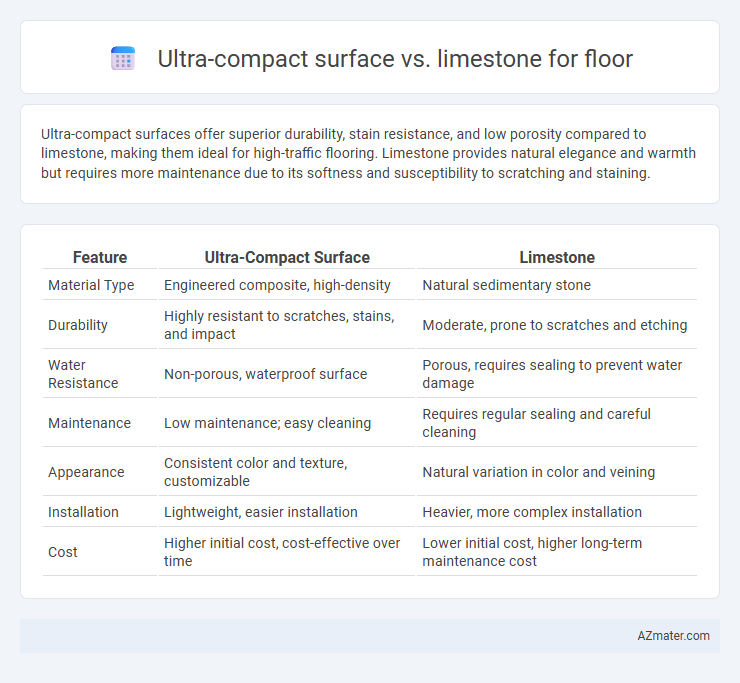Ultra-compact surfaces offer superior durability, stain resistance, and low porosity compared to limestone, making them ideal for high-traffic flooring. Limestone provides natural elegance and warmth but requires more maintenance due to its softness and susceptibility to scratching and staining.
Table of Comparison
| Feature | Ultra-Compact Surface | Limestone |
|---|---|---|
| Material Type | Engineered composite, high-density | Natural sedimentary stone |
| Durability | Highly resistant to scratches, stains, and impact | Moderate, prone to scratches and etching |
| Water Resistance | Non-porous, waterproof surface | Porous, requires sealing to prevent water damage |
| Maintenance | Low maintenance; easy cleaning | Requires regular sealing and careful cleaning |
| Appearance | Consistent color and texture, customizable | Natural variation in color and veining |
| Installation | Lightweight, easier installation | Heavier, more complex installation |
| Cost | Higher initial cost, cost-effective over time | Lower initial cost, higher long-term maintenance cost |
Introduction to Ultra-Compact Surface and Limestone Flooring
Ultra-compact surface flooring, known for its exceptional durability and resistance to scratches, stains, and heat, offers a modern aesthetic ideal for high-traffic areas. Limestone flooring provides a natural, timeless appeal with its unique textures and color variations, though it requires regular sealing to maintain its beauty and durability. Both materials serve distinct design needs, with ultra-compact surfaces excelling in performance and limestone offering organic warmth.
Material Composition and Formation
Ultra-compact surfaces are engineered from a combination of natural minerals, porcelain, and advanced resins, creating a dense, non-porous material with superior durability. Limestone is a sedimentary rock primarily composed of calcium carbonate formed from marine organism remains and mineral deposits over millions of years. The synthetic nature of ultra-compact surfaces offers enhanced resistance to scratches and stains compared to the softer, more porous limestone, which is prone to weathering and requires sealing for floor applications.
Durability and Strength Comparison
Ultra-compact surfaces exhibit higher durability and strength compared to limestone, due to their dense, non-porous composition that resists scratches, stains, and impact damage. Limestone, a softer natural stone, is more prone to chipping, erosion, and staining under heavy use or exposure to acidic substances. The superior wear resistance and minimal maintenance of ultra-compact flooring make it an ideal choice for high-traffic areas requiring long-lasting performance.
Aesthetic Versatility and Design Options
Ultra-compact surfaces offer exceptional aesthetic versatility with a wide range of colors, textures, and finishes that mimic natural materials like stone and wood, providing more innovative design options compared to limestone. Limestone floors bring classic elegance and organic patterns but have limited color variety and are prone to staining, restricting design flexibility. The durability and low maintenance of ultra-compact surfaces make them suitable for diverse interior styles, whereas limestone requires careful sealing and upkeep to retain its visual appeal.
Maintenance Requirements and Ease of Cleaning
Ultra-compact surfaces offer superior resistance to stains, scratches, and water, making maintenance requirements minimal and cleaning effortless with just a damp cloth and mild detergent. Limestone, being porous and softer, demands regular sealing and careful cleaning to prevent stains and damage, increasing ongoing maintenance efforts. The non-porous nature of ultra-compact materials significantly reduces the buildup of dirt and bacteria, enhancing ease of cleaning compared to limestone floors.
Stain, Scratch, and Heat Resistance
Ultra-compact surfaces exhibit superior stain resistance compared to limestone, as their non-porous composition prevents liquid absorption and makes cleaning easier. They also outperform limestone in scratch resistance due to their high-density structure and durable resin binding, which withstands abrasive impacts effectively. Heat resistance is significantly higher in ultra-compact surfaces, maintaining integrity against hot pots or pans, whereas limestone is prone to thermal shock and discoloration under extreme heat.
Slip Resistance and Safety Considerations
Ultra-compact surface flooring offers superior slip resistance due to its non-porous, dense composition and high coefficient of friction, making it ideal for high-traffic and wet areas. Limestone, while aesthetically pleasing, tends to be more porous and can become slippery when wet, increasing the risk of slips and falls without appropriate treatments. Safety considerations prioritize ultra-compact surfaces in environments requiring durable, slip-resistant flooring to minimize accidents and ensure compliance with safety regulations.
Sustainability and Environmental Impact
Ultra-compact surfaces exhibit superior sustainability compared to limestone due to their lower water absorption and higher durability, reducing the need for frequent replacements and minimizing resource consumption. Their production often involves recycled materials and advanced manufacturing processes that lower carbon emissions, whereas limestone extraction contributes to habitat disruption and significant carbon footprints from quarrying activities. Choosing ultra-compact surfaces enhances environmental impact mitigation through enhanced longevity, reduced maintenance, and more eco-friendly sourcing.
Cost Analysis and Long-Term Value
Ultra-compact surfaces typically present higher upfront costs compared to limestone flooring, primarily due to advanced manufacturing processes and enhanced durability features. Limestone, while more affordable initially, may incur increased maintenance expenses over time due to its porous nature and susceptibility to wear. Evaluating long-term value, ultra-compact surfaces offer superior resistance to scratches, stains, and moisture, resulting in lower upkeep costs and extended lifespan, which can offset the initial investment significantly.
Best Applications for Ultra-Compact Surface vs Limestone
Ultra-compact surfaces excel in high-traffic commercial spaces and modern residential kitchens due to their extreme durability, resistance to scratches, stains, and heat, and minimal maintenance requirements. Limestone is best suited for low-traffic, elegant settings such as formal living areas and bathrooms, where its natural porous texture and warm tones create a luxurious ambiance but require regular sealing and careful upkeep. Choosing ultra-compact surfaces is ideal for environments demanding robust performance and hygiene, while limestone thrives in decorative, low-impact zones prioritizing natural beauty.

Infographic: Ultra-compact surface vs Limestone for Floor
 azmater.com
azmater.com